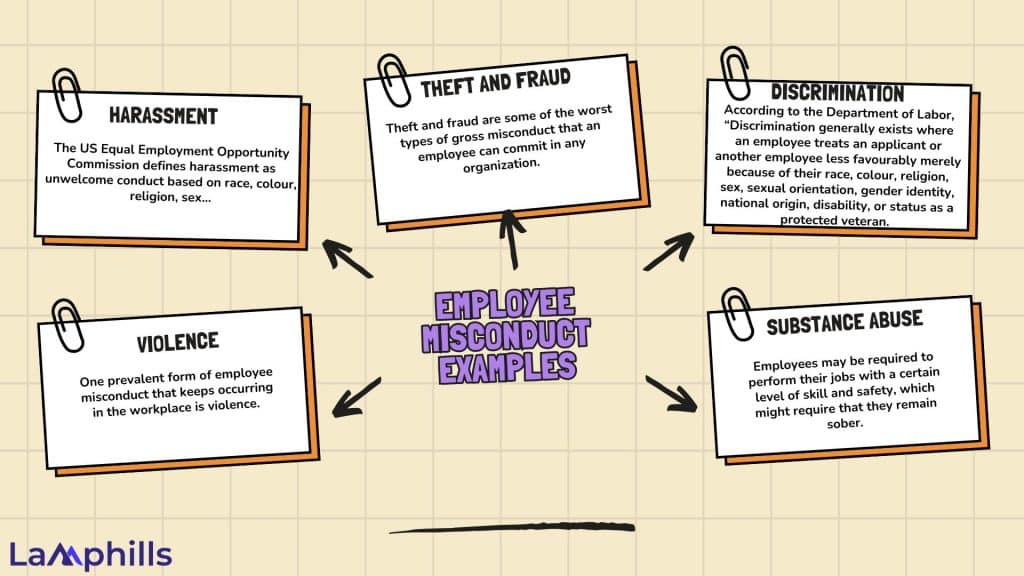Are you aware that certain employees deliberately cause crises in their workplaces? Unfortunately, what you might be thinking is correct! Every year around the globe, businesses and companies suffer the consequences of employees who disregard safety precautions and endanger their employers. Stealing, fraud, harassment, uncouth behaviour, and other problems can happen to the best employers. Addressing employee misconduct effectively is essential to building a safe, inclusive workplace and creating an ethical organizational culture.
In this article, we’ll examine what employee misconduct is all about, types of employee misconduct, and steps to minimize reputation damage. Come with me!
Key Points
- Employee misconduct is any employee action that goes against company policy or behaviour standards and can create a hostile work environment.
- Misconduct can lead to termination and negatively impact the company’s productivity, morale, and reputation.
- Types of employee misconduct include general and gross employee misconduct.
- Common examples of misconduct include harassment, theft and fraud, discrimination, violence, substance abuse.
What Is Employee Misconduct?
Employee misconduct is any employee action that goes against company policy or behaviour standards and can create a hostile work environment. It occurs when an employee refuses to obey workplace standards or procedures, engages in inappropriate behaviour, violates the law, intentionally damages corporate assets, or harms their workplace. It can range from trivial mistakes, such as forgetting to arrive on time, to more severe examples of outright fraud, lying about qualifications, or purposefully harming coworkers.
Furthermore, employee misconduct is a significant issue that often leads to immediate termination. It can have many negative consequences for a firm, including lower employee morale and productivity, higher turnover rates, increased liability exposure, litigation, fines, or other penalties for breaking laws governing employee behaviour.
Don’t take employee misconduct lightly. According to research by Vault Platform, misconduct cost U.S. businesses $20 billion in 2020.
What Are the Types of Employee Misconduct?
There are two types of employee misconduct: general and gross. Although one is less severe than the other, both require employers to take action in response to negative behaviour from employees.
#1. General Misconduct
The first type, general misconduct, refers to an activity not intended to harm others or the firm. It is usually not necessary to immediately terminate any employee when found guilty. However, it does mean that the employee’s immediate supervisor and HR must document and carry out any disciplinary action to fix the situation. An employee who is consistently late to work or makes an offensive remark to a coworker is an example of general employee misconduct. Their acts are negative, yet they are not intended to sabotage the company.
Additional examples of general misconduct could include:
- Inaccurately providing information on a job application—discovered after the person has been employed
- Not following the instructions of a direct supervisor.
- Getting caught smoking in a non-smoking location on the property.
These are offenses, but they can be corrected and do not require termination on the spot. First-time issues may require nothing more than a written warning for employee misconduct and monitoring of the employee for some time. Or it may need more decisive action, such as suspension.
#2. Gross Misconduct
On the other hand, gross employee misconduct is a term used in employment law. In gross misconduct, the misconduct is severe enough to affect the company’s standing or production. The employee receives summary dismissal for such misconduct, even without prior notice. The degree of seriousness in its definition varies from one state to another. Still, it covers cases where employees fail to perform their work obligations due to unethical, illegal, or inappropriate behaviour.
Examples of gross misconduct may include, but are not limited to:
- Theft of property or finances from the company (including co-workers, customers, and vendors) or by way of fraudulent transactions
- Property damage or negligence caused intentionally by an employee
- Failure to follow safety protocols that put the employee and co-workers at risk
- Serious insubordination.
Now that we have grasped the types of employee misconduct, let’s see some of its examples.
Employee Misconduct Examples

As mentioned above, there are many examples of employee misconduct. However, the most common ones are the following:
#1. Harassment
The US Equal Employment Opportunity Commission defines harassment as unwelcome conduct based on race, colour, religion, sex (including sexual orientation, gender identity, or pregnancy), national origin, older age (beginning at age 40), disability, or genetic information (including family medical history).
Harassment becomes unlawful where i) enduring the offensive conduct becomes a condition of continued employment, or ii) the conduct is severe or pervasive enough to create a work environment that a reasonable person would consider intimidating, hostile, or abusive. Harassment can happen between employers and employees or between employees. When it involves explicit or implicit sexual associations, it becomes sexual harassment.
#2. Theft and Fraud
Theft and fraud are some of the worst types of gross misconduct that an employee can commit in any organization. If it gets out, it is illegal, immoral, and highly damaging to a company’s reputation. It can lead to the loss of potential customers and legal and financial troubles.
Several forms of fraud include embezzlement, credit card theft, tax evasion, and voter or insurance fraud. However, there are other forms of theft and fraud, such as stealing merchandise, using company resources for personal reasons, stealing from co-workers, etc.
#3. Discrimination
According to the Department of Labor, “Discrimination generally exists where an employee treats an applicant or another employee less favourably merely because of their race, colour, religion, sex, sexual orientation, gender identity, national origin, disability, or status as a protected veteran. It may also occur if an employer disciplines, terminates, or takes unfavourable actions against an employee or job applicant for discussing, disclosing, or asking about pay. Discrimination can be against a single person or a group.”
#4. Violence
One prevalent form of employee misconduct that keeps occurring in the workplace is violence. They can appear to varying degrees. While some workers at some companies don’t have severe issues with violence, others do. It is one of the primary reasons why businesses establish explicit guidelines outlining acceptable behaviour at work and maintain a zero-tolerance policy for it. When there is violence, dismissal happens right away.
Violence is the threat of physical contact meant to harm another person. This can include actual bodily harm brought on by an employee’s violent behaviour, as well as threats of violence or fierce pushing and shoving.
Moreover, it is among the most prevalent kinds of employee misconduct. Harassment or bullying has accounted for 50% of all misconduct.
Some examples of workplace violence include bullying, stalking, assault with a deadly weapon, threatening employees, supervisors, or customers, etc.
#5. Substance Abuse
Employees may be required to perform their jobs with a certain level of skill and safety, which might require that they remain sober. When an employee is under the influence of drugs or alcohol on the job site, it can risk accidents. This type of misconduct can also substantially threaten the company’s image in the case of media involvement. The HR department must take disciplinary action or issue written warnings to an employee who uses drugs during working hours.
Creating an Action Plan and Misconduct Policy
Business owners and management must establish precise policies on employee misconduct. This will enable managers and HR to:
- Recognize misconduct and identify who might need to be involved in the process.
- Properly investigate infractions.
- Proceed with the appropriate level of discipline.
When employees or managers spot misconduct, they will be more likely to report it if there are clear guidelines about the process. Here are some valuable tips for drafting yours.
#1. Identifying Who Might Need to Be Involved in the Process
Share the process for filing an employee misconduct report, such as alerting their manager or HR and providing a verbal or written statement. When employees report misconduct, they must know whom to contact for specific violations. This will eliminate confusion and increase the chances of the misconduct being reported.
#2. Properly Investigating Infractions
Next, outline the procedure for investigating claims. You’ll want management or HR to:
- Gather information about the incident, such as the date, time, and circumstances. Also, get a list of witnesses and their contact information.
- Interview employees involved separately and privately. Be sure to take meticulous notes and keep a record of all statements.
- Review relevant evidence or documentation, such as emails, performance reviews, previous disciplinary records, or other correspondence.
Once all the information is gathered and reviewed, your team can decide the next steps based on the results.
#3. Proceeding With the Appropriate Discipline
Not all misconduct requires legal action or termination. It’s essential to determine the appropriate level of response. Be sure your policy is clear about what actions require discipline and how to do it reasonably and consistently for all employees.
For example, minor infractions might require warnings or corrective actions. Others might necessitate suspension, transfer, or firing. When in doubt, remember the aim shouldn’t be to punish the employee but to rectify the situation and ensure other employees comply with your policy.
How Do You Write Up an Employee Misconduct?
An employee can improve, and a transparent, equitable, well-documented write-up shields the employer from legal action.
Employee write-ups are never fun for managers or the offender. However, they’re a necessary part of remedying the misconduct and, when done right, can protect your company if the employee takes legal action against you.
Here’s how to write up employee misconduct in four simple steps.
#1. Include All the Facts
When filling out an employee disciplinary form, be as specific as possible. Include as much information as you can. Not only will this protect you from potential legal action, but you can also study misconduct records when planning preventive strategies.
On every write-up form, include:
- The employee’s full name and employee number
- Time and date of the write-up and specific incidents
- Reason for the write-up, in detail
- Witness accounts confirming the employee’s misconduct
- Times and dates of previous write-ups and incidents
- Fill your report with facts, but never opinions or inferences about the employee’s behavior. If you take disciplinary action against them based on assumptions and they feel it’s unfair, you could be slapped with regulatory fines and/or a lawsuit.
Provide as much information as possible regarding the employee’s actions; never include judgments or conclusions. If you discipline someone based on presumptions and they believe it’s unjust, you may face legal action from them as well as regulatory sanctions.
Check out our employee discipline action form template. This template will guide you in documenting employee misconduct accurately and consistently.
Lamphills Employee Discipline Action Form Template
#2. Reference the Company’s Policies
In addition to the facts of the misconduct, an employee write-up should include references to your company’s policies. What policy did they break? What are the consequences? Clearly state how the employee’s behavior violated the policy.
Give the employee a quote from your policy and point them to the appropriate section in their handbook. You can also affix a printout of the policy page to the report for your records.
These actions demonstrate that your company handles the problem consistently and under its established standards. To prevent employees from claiming that you discriminated against them and their cases, ensure that equivalent sanctions are given for equal misconduct.
#3. Document Write-Ups Well
Documentation is crucial for the success of an investigation. It safeguards your company and its employees and can assist you in identifying dangerous areas that require attention.
As previously stated, take your time when writing up a worker. Apply the same form to every individual and situation. To assist you in keeping a record of the events, have the employee sign and date the completed form.
Additionally, save a copy of the completed form for your documentation. This is beneficial if you have to present proof that you addressed the wrongdoing appropriately. Disciplinary records also highlight recurring incidents and employees with multiple write-ups so you can take preventive steps.
#4. Provide Guidance on How to Correct the Conduct
Finally, give the employee a chance to change their ways. Explain why their conduct was wrong and what behavior is expected instead. Then, give specific details and a deadline on how to improve.
If you write up an employee misconduct for being late regularly, for instance, you could explain that although the person signed a contract promising to work 37.5 hours a week, they have only been putting in 30 hours because they are consistently late. Next, request that by the end of the week, they pledge to put in the necessary 7.5 hours a day of effort.
Put a definite end to your directions by stating the consequences. What will happen if workers don’t correct their conduct by the deadline? Remember to reference the relevant business policy while deciding on disciplinary actions.
A fair and thorough disciplinary report allows the employee to improve and protects your organization in the event of legal action.
How Do You Take Action on an Employee for Misconduct?: Steps to Minimize Damage
Resolving employee misconduct is a complex procedure considering several variables, such as the accused party’s prior behavior and work history. When a worker engages in improper behavior, coworkers should report it, and supervisors should react appropriately. The type of misconduct will determine the sanctions, including an immediate termination, a final written warning, or a verbal warning.
To help you take disciplinary steps against that employee as a manager, I have created a comprehensive checklist guide to help you:
How to Address and Handle Employee Misconduct Checklist
Disciplinary Responses to Employee Misconduct
While serious misconduct should typically lead to an employee’s immediate termination, less serious infractions may instead cause a routine warning procedure to be initiated. Typical disciplinary actions for employee misconduct include:
#1. Verbal Warning
Managers commonly give employees a verbal warning before officially going on the record to report misconduct, meaning they talk to the offending employee to explain company policy and then create an improvement plan if relevant. A verbal warning alerts employees about an issue and allows them to correct it. Some employees may not realize they have committed misconduct; a verbal warning helps them address the behavior.
#2. Probation
Employees can also be put on probationary periods, during which their actions are closely monitored by their employer. They may have to sign a form acknowledging why they’re on probation. Probation typically lasts 60 or 90 days and can be subject to extension if an employee doesn’t show improvement.
#3. Dismissal
Firing an employee is usually the last resort for employers trying to correct a behavioral issue. In cases of gross misconduct, dismissing the employee may be the only appropriate action for your business. Document how you informed the employee of their termination and file it with HR.
Bottom Line
In conclusion, addressing employee misconduct is never easy, but it’s essential for fostering a productive and harmonious workplace. By taking swift, transparent, and fair actions, businesses and companies not only protect their reputation but also create an environment of accountability and respect. In addition, dealing with misconduct effectively isn’t just about enforcing rules—it’s about ensuring every team member feels valued, supported, and committed to shared success.
Similar Articles
- How to Create an Effective Crisis Management Team: 6 Key Steps
- Types of Crises in Public Relations: How to Identify and Manage Them
- 9 Reputation Management Red Flags That Scream






